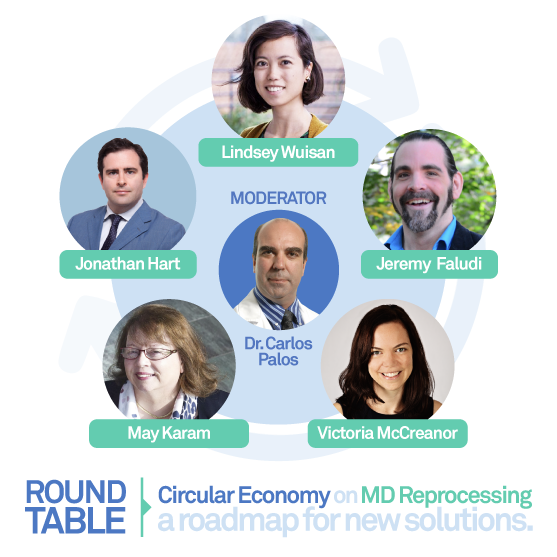
Circular Economy in Medical Devices reprocessing E-Modules
How to navigate on TalentLMS
We’ve improved the overall experience for our E-modules making them more engaging, easy to use and user-friendly.
“Circular Economy in Medical Devices reprocessing: a roadmap for new solutions” E-Modules
General Announcement
Every day, tons of healthcare waste are produced worldwide, aggravating the health of our planet. Combined with new forms of waste related to the pandemic, this reality is seriously compromising the quality of living beings.
As responsible for this, we must act to change it. We must move towards a Circular Economy – renew, remake, share – instead of a linear economy – take, make, dispose.
New design strategies can be adopted to implement Circular Economy in the healthcare
Servitization is an important strategy in the implementation of a Circular Economy, transforming all aspects, from design to delivery, transportation and recycling.10
Due to Healthcare-associated infections, lower costs of acquisition, and no reprocessing, a recent trend toward the use of single-use MD has been observed.11 However, this strategy of single-use is not in line with a Circular Economy. Alternative reprocessing methods, namely low temperature instead of steam, could improve efficiency.12
Unsolved issues related to externalization of medical device reprocessing with its pros and cons do require a judicious evaluation through Health Technology Assessments.13
To that end, we are proud to be focusing on the role of Medical Device reprocessing as a circular economy solution.

Lindsey Wuisan

Jeremy Faludi

Victoria McCreanor

May Karam

Jonathan Hart

Lindsey Wuisan
Expert on Circular Economy, Environmental Policy and Management
Circular Economy Lisbon, Portugal
SYNOPSIS:
During the first webinar, Lindsey Wuisan (MSc, NL/PT) will kick-off the series by giving a general overview of Circular Economy (CE) and the opportunities for the healthcare sector. The presentation will start with the environmental imperative and an introduction to the concept and main principles. Furthermore, key strategies to implement CE in practice will be presented as well as the opportunities (and risks) for the healthcare sector. Lastly, inspiring examples of circular initiatives in the healthcare sector will be shared.
DATE: 25th of May
You can see factsheet & recording

- In a linear economy, the overexploitation and use of (natural) resources lead to significant environmental harm.
- The healthcare sector also has a significant ecological footprint and generates a lot of waste, largely due to widespread use of single-use disposables (materials and devices).
- A CE is a regenerative system in which the use of natural resources is minimized, waste and pollution are prevented, through innovative business models and sustainable modes of production and consumption.
- In a circular economy, emphasis is on upstream design solutions that extend product lifetime (design for reuse, repair, remanufacturing) and enable high-quality recycling, while regenerating ecosystems.
- The healthcare sector can reduce its ecological footprint by using fewer disposables and adopting circular practices. These contribute to sustainable development, create socio-economic opportunities, improve public health and cut costs at the same time.

Jeremy Faludi
Assistant Professor of Sustainable Design Engineering
TU Delft, Netherlands
SYNOPSIS:
Medical Device industry values safety, as it should. But throwing away entire products just to avoid cleaning them creates air pollution, water pollution, and other waste that damages people’s health.
Don’t just treat the patient in the room, treat the other 8 billion patients in the world as well.
DATE: 23rd of June

- A circular economy is more than just recycling. Before that, we need to reduce consumption, repair, reuse, refurbish, and remanufacture, to save both environmental impacts and money.
- Barriers to circular economy medical devices are real, but they can be overcome. We need to overcome them because healthy people require a healthy world.
- Current economics drives manufacturers toward planned obsolescence, but they must switch business models and design methods to drive the circular economy.
- Purchasers have leverage, both in buying more sustainable products based on LCA or other quantified impact assessments and subscribing to new business models like product-service systems. If companies don’t offer them, push them to provide the data and/or the business models.

Victoria McCreanor
Health Economics Research Fellow
Greater Brisbane, Australia
SYNOPSIS:
When considering which sterilizer is right for a particular setting, there is more to think about than the up-front costs of the sterilizer system itself. Concepts used in health economic evaluation can be used to assess the longer term costs and benefits of different options, including environmental considerations, in different settings. This webinar will cover an overview of health economic evaluation concepts, factors related to the sterilizer system, the instruments/devices being sterilized and wrap up with how to bring it all together.
DATE: 22th of September

- Important to look beyond the up-front costs of the sterilizer
- There are large differences in energy and water consumption: important in current environment
- Effect of different sterilizing processes on instruments important consideration (affects costs and carbon footprint)
- Consumables/disposable items also contribute to carbon footprint
- Principles of health economics can be used to evaluate decisions your context

May Karam
EORNA President Infirmière de bloc Opératoire Diplômée D'etat (IBODE)
Paris, France
SYNOPSIS:
We have to be aware of the importance of having to preserve our environment.
It is time to change our working methods including in the healthcare sector to reduce the carbon footprint and preserve our planet.
Sterilization and the Operating Room are side-by-side when it comes to Patient Safety. One does not work without the other and both are critical in a hospital.
In general, large hospitals have their own sterilization department. There are also outside facilities that provide this service and work as a sterilization department.
Would it be interesting to have a sterilization service onsite, close to the operating room and the health care services, or to outsource this service to facilities far away from the hospital?
The question is not new and both solutions have advantages and disadvantages because we must take into account the economic aspect, the modalities to continue to ensure safe and quality patient care. But let’s not forget that the issue is not only about organization and the place where the MD reprocessing will be done. It becomes imperative to pay attention to avoid waste, to adapt our methods in the operating room and in the sterilization department and to work in a circular economy perspective, for the patient, the health system, and for our Planet.
DATE: 27th of October

- CSSDs play an important role in patient care, patient safety and infection prevention: Reprocessing of MDs is an indirect patient care that must be provided by skilled personnel. It is extremely important to provide a high quality and reliable process by applying validated and up-to-date procedures.
- On-site CSSD has advantages, especially for large healthcare facilities with a large volume of MD to be processed. The proximity of the CSSD saves time for the MD processing since there are no transportation to consider. However, this entails enormous costs in terms of equipment, materials, personnel and maintenance.
- Off-site CSSD is less costly for small health care facilities which have less volume of MD to be processed. However, it is important to organize it very carefully, considering all the steps of the process to avoid problems such as reprocessing errors, loss of MD or delays in delivery.
- In a nutshell, either choice can be beneficial to a healthcare facility. The important thing is to adapt the best solution to the needs, to forget about prejudices and to be objective when taking decisions.
- The health of the Earth is deteriorating! It is becoming urgent to “think green” and to act for a positive change in our way of life and in our workplace. We realize how important it is to “think green” in CSSDs by saving costs, stopping the waste and finding sustainable solutions for reprocessing RMD. Several examples in healthcare, showcase the impact of Circular Economy on this cost reduction (SUD, medical waste, water, energy, etc.). There is also literature and governmental directives (eg. ISO14001) to guide us, but what is important is that each of us becomes an actor in this change.

Jonathan Hart
Biomedical Engineer at Direzione Sanitaria Campus Bio-medico, Rome
Roma, Itália
SYNOPSIS:
As waste management, pollution and climate change are global issues at all levels, circular economy is, for all sectors including healthcare, a necessary solution and an opportunity for sustainability. The success of circular economy models in healthcare requires, in order to be developed and adopted, a joint effort on the part of the industry, policymakers and users.

- HTA is a multidimensional methodology that allows a comprehensive and evidence-based approach to a circular economy in healthcare.
- HTA is a useful tool for appraising whether devices or solutions that are proven to be environmentally sustainable are also clinically effective and acceptable.
- It is important to assess how circular economy models (with smaller CO2 footprints) compare to current practice in terms of clinical outcomes and effectiveness, as well as efficiency and organizational factors. Life cycle analyses and economic evaluations alone do not provide conclusive evidence to decision-makers.
- HTA can help define requirements that need to be met by industry, institutions, and healthcare professionals in developing and applying circular economy solutions to healthcare.
- There is a growing awareness among healthcare professionals and scientific societies of environmental issues. The circular economy is becoming not only the goal in new business models but also the means to achieve economic sustainability and meet service requirements.






